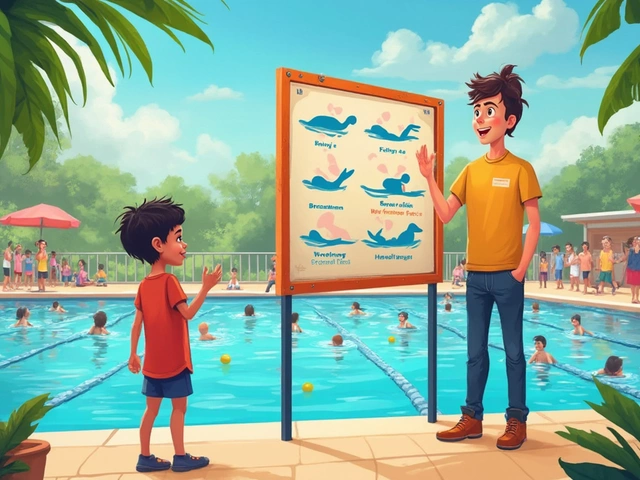So, you're dipping your toes into the world of swimming and wondering how often to take the plunge? Well, you're in the right place! As a beginner, it's super important to gradually ease into your swim routine to build confidence and skill. But how often should you really be swimming? Let's break it down.
For starters, think about hitting the pool two to three times a week. This frequency allows you enough time to learn and adapt without overwhelming yourself. Swimming less than twice a week might slow your progress, as you'll likely need to re-familiarize yourself each time. More than three times, and you risk overexertion or burnout—especially if those muscles aren't used to all the water work!
A fascinating tidbit for those just starting: water is about 800 times denser than air. This means that, even if you don't feel it right away, you're giving your body a robust workout each time you swim. It's like hitting the gym with each stroke!
Getting Started
When you're just at the beginning of your swimming journey, setting the right foundation is key. The first thing to focus on is comfort in the water. Don't worry too much about speed or technique at first; the goal is to feel relaxed and steady when you're in the pool.
A great way to start is by spending some time just floating and getting used to the feel of water supporting your body. Try practicing some basic strokes like freestyle or backstroke in a shallow area so you can stand up easily if needed. This helps build confidence and gives you a chance to get a feel for different movements.
Gear Up
Investing in the right gear makes a huge difference and keeps you comfortable. Consider purchasing a good pair of goggles to protect your eyes and improve your underwater vision. A snug-fitting swimsuit and a swim cap can help you move through the water more efficiently.
Planning Your Sessions
Create a simple schedule to help you stay consistent with your swim frequency. Decide which days and times work best for you, and try to stick to that routine. For instance, you could plan to swim every Monday, Wednesday, and Saturday. Consistency is important to help build skills and strength.
Joining a Class or Club
If you’d like some guidance, think about joining a beginner swimming class. Having an instructor show you the ropes can make a world of difference in learning the right techniques and staying motivated. Plus, it can be more fun and social!
To give you an idea: swimming works nearly every muscle in your body and, according to studies, can burn around 400-600 calories per hour, depending on intensity. So even if you're just starting out, remember every session is benefiting you more than you might realize.
Finding Your Rhythm
Alright, so you've decided to commit to swimming a couple of times a week. But what does finding your rhythm really look like for a beginner swimming? Let's get practical. This part is all about crafting a routine that not only helps you improve but also keeps things fun and manageable.
Start with Short Sessions
Don’t bite off more than you can chew. Initially, aim for 20–30 minute sessions. This duration is perfect for building stamina and mastering the basics without feeling overwhelmed. As you get more comfortable, you can gradually increase your time in the water.
Mix Up Your Strokes
It's easy to find yourself doing a single stroke because it feels familiar. But variety is the spice of life, even in swimming! Experiment with different strokes like freestyle, breaststroke, and backstroke to engage different muscle groups and keep your sessions interesting.
Intervals and Rest
Ever heard of interval swimming? It's when you swim at a high intensity for a short period, followed by a rest. This technique is great for swim frequency because it helps build endurance efficiently. Try starting with 1-minute swims followed by 1-minute breaks.
Track Your Progress
Keeping a swim journal can be incredibly motivating. Jot down how long you swam, which strokes you practiced, and how you felt after each session. It's amazing to look back and see how far you've come!
Mix in Dry-Land Exercises
Boost your swim by doing some dry-land exercises. Core workouts, leg lunges, or simple stretches can immensely benefit your swimming by strengthening the muscles you use most in the water.
Here's a quick look at how you might schedule your swimming week:
| Day | Activity |
|---|---|
| Monday | 20-minute swim, mixed strokes |
| Wednesday | Interval training, 1 min swim/1 min rest for 20 mins |
| Saturday | 30-minute relaxed swim, focus on technique |
Finding your rhythm in the pool takes a bit of trial and error, but that's part of the journey. Before you know it, swimming will become a natural part of your routine. Stick with it, keep the sessions enjoyable, and watch as you grow more confident and skilled with each splash!

Keeping It Fun
Swimming as a beginner should be all about fun and enjoyment, right? Let's face it; if it's not fun, you're less likely to stick with it. So, how can you ensure that your swimming journey is more of a joyful splash than a stale routine?
Add Some Variety
Routine can quickly turn to boredom if you keep doing the same thing over and over. Mix up your swimming sessions by trying different strokes or swimming in different environments, like outdoor pools or lakes (if safe and available). You could also join a beginners' swim class where instructors mix things up with group activities.
Bring a Friend
Everything's better with company! Invite a friend or family member to join you. Not only does it make the activity more enjoyable, but it also holds you accountable—no backing out of a swim when someone's counting on you!
Carly Johanson, a renowned swim instructor, once said, "The best way to learn swimming is to stay playful and curious in the water. It’s in the fun that technique and passion grow."
Set Mini Goals
Setting and achieving small milestones can make your swimming experience rewarding. Aim for things like swimming a certain number of laps without stopping or mastering a new stroke. Celebrating these small victories can boost your motivation and excitement.
Gear Up!
Get yourself some nice gear. A comfortable swimsuit or some funky goggles can make a big difference in how eager you are to hit the pool. Plus, some accessories like kickboards or fins might add a layer of excitement to your sessions.
Create a Playlist
Although waterproof headphones are handy, having a pre- or post-swim playlist can get you in the groove. Music can be a powerful motivator, setting the tone for a great swim session.
While it's easy to think about swimming as exercise, it can be a lot more enjoyable when you focus on the fun aspect. After all, nobody ever said that learning something new couldn't be a blast!
Avoiding Burnout
When you're just starting with swimming, it’s easy to get caught up in the excitement and push yourself too hard. But overdoing it can lead to burnout, and that’s something we definitely want to avoid. Here’s how to keep your swimming journey both safe and enjoyable.
Pace Yourself
If you're a beginner swimmer, pacing is crucial. Don't fall into the trap of thinking more is always better. Your body needs time to adjust to new physical activities. So, if you're swimming two or three times a week, make sure each session is balanced with rest days. Those rest days are when your muscles recover and grow stronger.
Set Realistic Goals
Setting small, achievable goals can keep your motivation high without pushing you past your limits. For instance, aim to improve your lap time, or work on mastering a new stroke. These fun challenges give you something to look forward to and celebrate when achieved.
Listen to Your Body
Pay close attention to how your body feels during and after swimming. Are you experiencing fatigue or soreness that lasts beyond 24 hours? If so, it might be a sign to cut back and give yourself a bit more recovery time. Consistency is essential, so avoiding injuries should be a top priority.
Make It Enjoyable
Don’t forget, swimming should be fun! Mix it up with different strokes, try some water aerobics, or even bring a friend along. Enjoyable sessions will keep you coming back for more and make avoiding burnout easier.
| Tip | Reason |
|---|---|
| Alternate Strokes | Prevents muscle fatigue |
| Use a Swim Checklist | Keeps sessions structured |
| Join a Swim Class | Provides social motivation |


